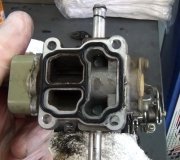The important thing as it relates to engine break in, and oil, is the cylinder walls and the piston rings. These are the parts that really MUST be properly addressed -- everything else is important (don't get me wrong). First realize this, the cylinder walls and the piston rings are NOT perfectly mated (yet). They have microscopic ridges or bumps on them that must be "worn" off. This is what is called break in. The break in, perfectly matches the cylinder walls to the piston rings so you can have the best compression possible - and this period will be VERY important (to you especially) because is seems that you will not be putting many miles on this engine.
An important step, BEFORE you fire the engine for the first time, is to pre-lube the engine. This is done by inserting a tool, connected to a drill, into the distributer hole. I have a Comp Cam pre lube tool (part number 4921) they are about 25 or 30 bucks. This will ensure that you have oil distributed properly BEFORE the initial start. OK - now to answer the question --LOL -- I suggest using straight 30 weight NON DETERGENT (if you can find it) and NON SYNTHETIC oil for the first to 800 to 1000 miles. The breaking process MUST be done as follows: Do not go over 60 MPH for the first 1000 miles. In these 1000 miles, vary your speed and drive up and down hills (if possible) often. Do not drive at steady consistant speeds. Do not "lug" the engine by driving in high gear. The reason for this is to vary the loads "gentaly" on the piston rings. If you load them too hard or too soft you will not get a good seal and it will result in smoking and/or excess oil consumption.
Also, drive these 1000 miles as soon as possible. Not all at once, but do not just drive on Sunday and every once in a while. It is important not to let oil drain off of the cylinder walls and condensation to accumulate in the crank case, which is what happens when you let any engine sit for a long period.
After the 800 to 1000 mile break in period, you should use 10w30. Also, if you want, you can use synthetic oil at this time. I do suggest switching to synthetic for reasons I will discuss, if you want. I further suggest using either Mobile 1 (not just Mobile) or Castrol oil brands -- for reasons I will also discuss if you want.
BTW - Im sure you replace the oil filter every time you replace the oil, but if it is possible and not too messy, try to replace the filter only after the first 200 miles. This is not really necessary, but I do it and I have found (when inspecting oil filters) excessive debris in it from the rebuilding process. If you do - do this -- be quick about it, it is a little messy, and be sure to add a little oil afterwards.
Saturday, November 7th, 2009 AT 10:51 PM




